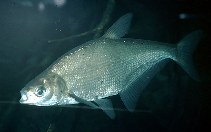Extracting Zope Eggs: A Parable

Given that the word "Zope" turns out to be a common name in German-speaking countries for a variety of carp (ballerus ballerus) I found the following note [1] strangely appealing, as well as appropriate.
Quote:
In the 1880's carp were considered so valuable that the federal government posted armed guards at the hatchery where these little "imports" were to be propagated. At that time, everyone believed the carp would become one of this country's greatest sport fishes. A century has almost passed and we all know how successful the stocking programs were, but the great expectations of this fish never materialized. Believe it or not, carp do have one merit going for them that was not originally considered. The female carp is an incredible egg producing machine. I have found some females that I would estimate were carrying an egg mass almost half their body weight. If these eggs are processed correctly, they make an excellent frozen food.
Every spring through early summer, carp congregate and ascend many rivers and creeks to spawn. When they are running at their peak, they will choke a stream from bank to bank. The female carp can easily be distinguished from the male by her usually larger size and greatly distended belly. I have taken carp by spear, bow and arrow, and fishing pole, but prefer the spear because it is the quickest and easiest to use. Regulations vary from state to state governing when and how "rough fish" can be legally speared. The information can be obtained from a conservation officer or state agency responsible for managing the fisheries resource.
There is really no reason why anyone must wage a holy war against these invading infidels from a foreign land. I would hope everyone uses a little restraint and common sense - take only what you intend to use. I have found that four or five large females will supply my needs for three to six months depending on how many fish I have at that time. I have tried repeatedly and unsuccessfully to strip the eggs from carp, but have had to settle for a much less glamorous method. I cut the belly from the anus to just below the gills. The two golden eggs can be found along each wall and easily removed. Disposing of the remains can be a problem and the Minnesota fisheries regulations prohibit returning carp to the water or littering them along the banks, but this is usually ignored by most. When possible, carp should be buried and I have found they make an excellent garden fertilizer that grows the best sweet corn I have ever eaten.
The eggs must be cleaned correctly or they will remain in large clumps. I freeze the eggs for a couple of days and then allow them to thaw out. This makes separating the eggs from what I would describe as the placenta a great deal easier. I clean the eggs with a large fine meshed dip net by running water from a faucet on the eggs and squeezing the ball in the bottom of the net. The eggs quickly separate from the placenta which can be discarded. I package the eggs in ziploc bags, but prefer to first add some water that makes the mixture more spreadable. When the eggs are evenly distributed and the bags are sealed, I carefully stack them on a platter and place it in the freezer. I feed the eggs in the same way I do brine shrimp, but sparingly in the first few days to allow the fish time to switch to their new food. Once this adjustment period has passed, the fish accept carp eggs just as readily and eagerly as brine shrimp.
[1] Article quoted in whole from the Google cache: the origina domain seems to have expired